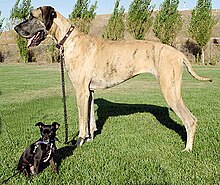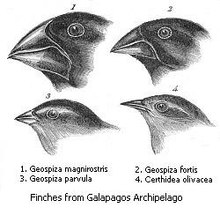This is an old revision of this page, as edited by Guettarda (talk | contribs) at 03:01, 12 February 2007 (rv, this material was determined to be unsuitable for Misplaced Pages, and most certainly doesn't belong here). The present address (URL) is a permanent link to this revision, which may differ significantly from the current revision.
Revision as of 03:01, 12 February 2007 by Guettarda (talk | contribs) (rv, this material was determined to be unsuitable for Misplaced Pages, and most certainly doesn't belong here)(diff) ← Previous revision | Latest revision (diff) | Newer revision → (diff)In biology, a group of organisms is said to have common descent if they have a common ancestor. The most recent common ancestor is the most recent individual or population which is an ancestor of all of the species being referenced. The theory of universal common descent proposes that all organisms on Earth are descended from a common ancestor or ancestral gene pool. It is the accepted theory for the origin of modern biological species among biologists.
History
See also: History of evolutionary thoughtThe first suggestion that all organisms may have had a common ancestor and diverged through random variation and natural selection was made in 1745 by the French mathematician and scientist Pierre-Louis Moreau de Maupertuis (1698-1759) in his work Vénus physique. Specifically:
- "Could one not say that, in the fortuitous combinations of the productions of nature, as there must be some characterized by a certain relation of fitness which are able to subsist, it is not to be wondered at that this fitness is present in all the species that are currently in existence? Chance, one would say, produced an innumerable multitude of individuals; a small number found themselves constructed in such a manner that the parts of the animal were able to satisfy its needs; in another infinitely greater number, there was neither fitness nor order: all of these latter have perished. Animals lacking a mouth could not live; others lacking reproductive organs could not perpetuate themselves... The species we see today are but the smallest part of what blind destiny has produced..."
In 1790, Immanuel Kant (Königsberg (Kaliningrad) 1724 - 1804), in his Kritik der Urtheilskraft, states that the analogy of animal forms implies a common original type and thus a common parent.
Charles Darwin's grandfather, Erasmus Darwin, hypothesized in 1795 that all warm-blooded animals were descended from a single "living filament":
- "...would it be too bold to imagine, that all warm-blooded animals have arisen from one living filament, which THE GREAT FIRST CAUSE endued with animality...?" (Zoonomia, 1795, section 39, "Generation")
In 1859, Charles Darwin's The Origin of Species was published. The views about common descent expressed therein vary between suggesting that there was a single "first creature" to allowing that there may have been more than one. Here are the relevant quotations from the Conclusion:
- "robably all of the organic beings which have ever lived on this earth have descended from some one primordial form, into which life was first breathed."
- "The whole history of the world, as at present known, ... will hereafter be recognised as a mere fragment of time, compared with the ages which have elapsed since the first creature, the progenitor of innumerable extinct and living descendants, was created."
- "When I view all beings not as special creations, but as the lineal descendants of some few beings which lived long before the first bed of the Silurian system was deposited, they seem to me to become ennobled."
The famous closing sentence describes the "grandeur in this view of life, with its several powers, having been originally breathed into a few forms or into one." The phrase "one form" here seems to hark back to the phrase "some few beings"; in any case, the choice of words is remarkable for its consistency with recent ideas about there having been a single ancestral "genetic pool".
Examples of common descent
Artificial Selection

Artificial selection offers an example of common descent in a controlled environment. To perform artificial selection, one begins with a particular species (following examples include a wolf and wild mustard) and then, at every generation, only allow certain individuals to reproduce, based on the degree to which they exhibit certain desirable characteristics. In time, it is expected that these characteristics become increasingly well-developed in successive generations. Many examples of artificial selection, like the ones below, occurred without the guidance of modern scientific insight.

Dog Breeding
Main article: dog breedingAn obvious example of the power of artificial selection is the diversity found in various breed in domesticated dogs. The various breeds of dogs all share common ancestry (being all ultimately descended from wolves) but were domesticated by humans and then selectively bred in order to enhance various features such as coat color and length or body size. To see the wide range of difference between the many breeds of dogs compare the Chihuahua, Great Dane, Basset Hound, Pug, and Poodle. Also compare this enormous diversity with the relative uniformity of wild wolves.
Wild Mustard
Farmers have cultivated many popular vegetables from the aggressive weed, wild mustard, by artificially selecting for certain attributes. Common vegetables such as cabbage, kale, broccoli, cauliflower, kohlrabi and Brussels sprouts are all descendents of the wild mustard plant. Brussels sprouts were created by artificially selecting for large bud size. Broccoli was bred by selecting for large flower stalks. Cabbage was created by selecting for short petioles. Kale was bred by selecting for large leafs.
Natural Selection
Main article: natural selection
Darwin's Finches
Main article: Darwin's finchesDuring Darwin's studies on the Galápagos Islands, Darwin observed 13 species of finches that are closely related and differ most markedly in the shape of their beaks. The beak of each species is suited to its preferred food, suggesting that beak shapes evolved by natural selection. Large beaks were found on the islands where the primary source of food for the finches is nuts and therefore the large beaks allowed the birds to be better equipped for opening the nuts and staying well nourished. Slender beaks were found on the finches which found insects to be the best source of food on the island they inhabited; their slender beaks allowed the birds to be better equipped for pulling out the insects from their tiny hiding places. The finch is also found on the main land and it is thought that they migrated to the islands and began adapting to their environment through natural selection.
Evidence of Universal Common Descent
See also: evidence of evolutionCommon biochemistry and genetic code
All known forms of life are based on the same fundamental biochemical organisation: genetic information encoded in DNA, transcribed into RNA, through the effect of protein- and RNA-enzymes, then translated into proteins by (highly similar) ribosomes, with ATP, NADH and others as energy currencies, etc. Furthermore, the genetic code (the "translation table" according to which DNA information is translated into proteins) is nearly identical for all known lifeforms, from bacteria to humans, with minor local differences. The universality of this code is generally regarded by biologists as definitive evidence in favor of the theory of universal common descent. Analysis of the small differences in the genetic code has also provided support for universal common descent.
Irrelevant Differences
Differences which have no relevance to evolution and therefore cannot be explained by convergence, tend to be very compelling support for the universal common descent theory.
Such evidence has come from two domains: amino acid sequences and DNA sequences. Proteins with the same 3-d structure need not have identical amino acid sequences; any irrelevant similarity between the sequences is evidence for common descent. In certain cases, there are several codons (DNA triplets) that code for the same amino acid. Thus, if two species use the same codon at the same place to specify an amino acid that can be represented by more than one codon, that is evidence for recency of a common ancestor.
Other similarities
The universality of many aspects of cellular life are often pointed as supportive evidence to the more compelling evidence listed above. These similarities include the energy carrier ATP, and the fact that all amino acids found in proteins are left-handed. It is possible that these similarities resulted because of the laws of physics and chemistry, rather than universal common descent and therefore resulted in convergent evolution.
Phylogenetic Tree

Another important piece of evidence is the fact that it is possible to construct detailed phylogenetic trees connecting the genes in species.
Due to horizontal gene transfer being a confounding factor in inferring phylogenetic trees of species, trees are most accurately created for specific genes. For example, given two distantly related bacteria that have exchanged a gene, a phylogenetic tree based on this gene will show them to be closely related because that gene is the same, even though most other genes have substantially diverged.
The importance of horizontal gene transfer in the reconstruction of very early evolution has received much interest in recent years. Carl Woese suggested the idea of a "Darwinian threshold", below which all living organisms could exchange material freely, but beyond which lineages were so complex that horizontal gene transfer between different domains became impossible, thus progressively giving rise to the three domains of life. Gogarten points out that because of horizontal gene transfer, there may have been no "molecular last common ancestor" (an individual which contained the "ancestor genes" of all modern genes) and that at any rate such an ancestor would probably not be the same as the actual last common ancestor of all lifeforms Note that none of these theories contradict the concept of universal common descent.
See also
References
- The earliest life-like forms probably exchanged genetic material laterally in a manner that is analogous to lateral gene transfer amongst bacteria. For this and other reasons, the most recent common ancestor may have been a genetic pool rather than an organism.
- Robin Knight; et al. (2001). "Rewiring the keyboard: evolvability of the genetic code". Nature Reviews - Genetics. 2 (1): 49–58. PMID 11253070.
{{cite journal}}: Explicit use of et al. in:|author=(help)
Further reading
- 29+ Evidences for Macroevolution: the Scientific Case for Common Descent
- Evolution of the Genetic Code, Book: Excellent description of protein coding in mitochondria, thermophiles, etc.
- The Tree of Life Web Project
| Origin of life | |
|---|---|
| History of research |
|
| Prebiotic synthesis | |
| Protocells | |
| Earliest organisms | |
| Research | |